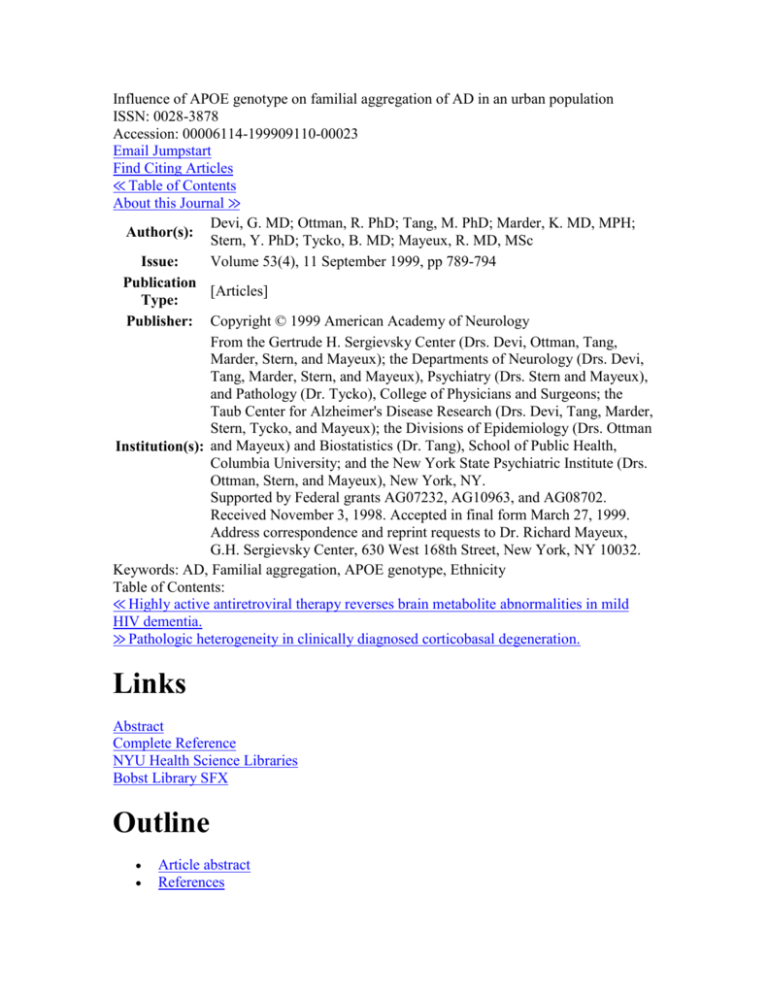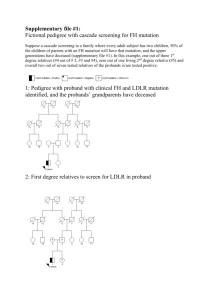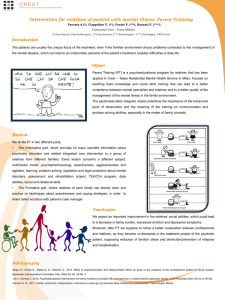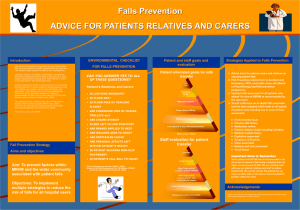Devi G, Ottman R, Tang MX, et al. Influence of the APOE genotype
advertisement

Influence of APOE genotype on familial aggregation of AD in an urban population ISSN: 0028-3878 Accession: 00006114-199909110-00023 Email Jumpstart Find Citing Articles ≪ Table of Contents About this Journal ≫ Devi, G. MD; Ottman, R. PhD; Tang, M. PhD; Marder, K. MD, MPH; Author(s): Stern, Y. PhD; Tycko, B. MD; Mayeux, R. MD, MSc Volume 53(4), 11 September 1999, pp 789-794 Issue: Publication [Articles] Type: Publisher: Copyright © 1999 American Academy of Neurology From the Gertrude H. Sergievsky Center (Drs. Devi, Ottman, Tang, Marder, Stern, and Mayeux); the Departments of Neurology (Drs. Devi, Tang, Marder, Stern, and Mayeux), Psychiatry (Drs. Stern and Mayeux), and Pathology (Dr. Tycko), College of Physicians and Surgeons; the Taub Center for Alzheimer's Disease Research (Drs. Devi, Tang, Marder, Stern, Tycko, and Mayeux); the Divisions of Epidemiology (Drs. Ottman Institution(s): and Mayeux) and Biostatistics (Dr. Tang), School of Public Health, Columbia University; and the New York State Psychiatric Institute (Drs. Ottman, Stern, and Mayeux), New York, NY. Supported by Federal grants AG07232, AG10963, and AG08702. Received November 3, 1998. Accepted in final form March 27, 1999. Address correspondence and reprint requests to Dr. Richard Mayeux, G.H. Sergievsky Center, 630 West 168th Street, New York, NY 10032. Keywords: AD, Familial aggregation, APOE genotype, Ethnicity Table of Contents: ≪ Highly active antiretroviral therapy reverses brain metabolite abnormalities in mild HIV dementia. ≫ Pathologic heterogeneity in clinically diagnosed corticobasal degeneration. Links Abstract Complete Reference NYU Health Science Libraries Bobst Library SFX Outline Article abstract References Graphics Table 1 Table 2 Article abstract Objective: To examine the influence of the proband's APOE genotype on AD among first-degree relatives in a community-based study of African Americans, whites, and Caribbean Hispanics. Methods: History of AD and demographic information were obtained on 1,073 siblings and parents of 312 patients with AD and 2,722 siblings and parents of 802 nondemented controls. APOE genotyping was performed on all 1,114 patients and controls. Results: A higher proportion of patients with AD (35%) than controls (27%) had one or more APOE-[small element of]4 alleles (p = 0.03). When compared with relatives of controls without an APOE-[small element of]4 allele, the risk for AD was increased in first-degree relatives of both patients (rate ratio [RR] = 1.9, 95% confidence interval [CI] = 1.2 to 3.1) and controls (RR = 1.8, 95% CI = 1.2 to 2.6) with one or more APOE-[small element of]e alleles, regardless of ethnic group. There was a similar trend of increased risk in relatives of patients without an APOE-[small element of]4 allele, but this was limited to Hispanics and African Americans. Conclusions: The presence of an APOE-[small element of]4 allele increases risk for AD among first-degree relatives, regardless of the probands' disease status, among all ethnic groups. Relatives of patients without an APOE-[small element of]4 allele were also at increased risk for AD among Hispanics and African Americans, suggesting that other genes or risk factors may influence risk. The APOE-[small element of]4 allele has been associated with AD in many studies. This association has been found to vary with age at onset of AD,1,2 ethnic group,3,4 sex,5 and study population (community-based or clinic-based).6,7 Because patients with AD are more likely than controls to carry APOE-[small element of]4 alleles, a greater proportion of APOE-[small element of]4 carriers would be expected among relatives of AD patients than among relatives of controls. Familial aggregation of late-onset AD may be partially explained by this association. Various studies have evaluated the relations between familial risk for AD and APOE genotype. Patients with AD who carry one or more APOE-[small element of]4 alleles are more likely to report a family history of AD than patients without an APOE-[small element of]4 allele.8,9 Conversely, patients with a family history of AD are also more likely to have an APOE-[small element of]4 allele than patients without a family history.10-12 The risk for AD has been found to be greater for relatives of patients with an APOE[small element of]4 allele than for relatives of patients without an APOE-[small element of]4 allele.13,14 However, this association may be stronger in female than in male relatives.14,15 In a community of African Americans, whites, and Caribbean Hispanics, we evaluated familial aggregation of AD in relation to the proband's APOE genotype. Because the APOE-[small element of]4 association with AD differs by ethnic group 3,4 and because APOE-[small element of]4 may influence familial aggregation 11,14 we considered both in the design of the study. Methods. Population. Patients and controls were part of a community-based, epidemiologic study of aging and dementia in Manhattan, New York. As previously described,3,16 a random sample of 50% of all persons over the age of 65, residing in the area and receiving Medicare, was obtained from the Health Care Finance Administration (HCFA). All were sent a letter from the HCFA explaining that they had been selected to participate in a study of aging by investigators at Columbia University. Participation rate was 68% in the HCFA-based random sample and did not differ by ethnic group. This HCFA-based random sample was enriched by participants from a previously established dementia registry, which included patients with AD and controls from the same community. A more detailed description of the dementia registry is provided elsewhere.3 Participants in neither the HCFA-based random sample (73%) nor the dementia registry (27%) were recruited based on their family history or their APOE-[small element of]4 status and were not aware of the goals of this particular study. All individuals had provided informed consent for an ongoing longitudinal study of aging. The ethnic group of the participants was classified by self-report, as described previously,16 into white, African American, and Hispanic. Using the 1990 United States Census questionnaire as a guide, individuals were asked whether they consider themselves white, black, or other, and were then asked whether they were Hispanic.17 If Hispanic, they were queried as to the country in which they were born. The majority (84%) of those classified as Hispanic were of Caribbean origin, predominantly from the Dominican Republic, with the remainder from Mexico and Central America. Although we are aware that whites, Hispanics, and African Americans are not mutually exclusive and homogenous groups in an urban American population, we used this classification because alternative methods to describe and study such populations are not currently available.18-21 Diagnosis. Diagnosis in patients and controls. Each patient and control received a structured neurologic examination and functional assessment by a physician and a neuropsychological battery (approximately 1 1/2 hours in duration) administered by a trained tester. The neuropsychological testing comprised a battery of memory, language, abstraction, and orientation subtests.22 The diagnosis of probable or possible AD was made by a consensus group of neurologists and psychologists after review of the clinical examination and the neuropsychological battery, independent of family history. Patients were defined by NINCDS-ADRDA criteria to be anyone with probable or possible AD.23 We included individuals with very mild AD (Clinical Dementia Rating scale of 0.5) among patients.24 Controls were defined as those who did not have evidence of cognitive impairment on neuropsychological examination or a chronic neurologic disease. Family history questionnaire and diagnosis in relatives of patients and controls. After the consensus conference, informants for the patients received a structured family history interview over the telephone and were most often spouses, children, or siblings of patients. Controls were interviewed directly over the telephone. The interview inquired about information on demographics for each first-degree relative (current age, age at death, sex, education). Screening questions for AD were: "Did (does) this person have memory problems or AD?" and "Was (is) this person unable to care for him/herself?" If either of the screening questions was endorsed, a set of follow-up questions was asked to establish the level of certainty of the diagnosis of AD. If neither screening question was endorsed, no follow-up questions were asked. The follow-up questions were as follows: 1. Did the person have a gradual and progressive loss of memory? 2. Was the person confused and disoriented most of the time? 3. Did the person have difficulty recognizing family members? 4. Was the person seen by a physician for this condition? If yes, was the diagnosis Alzheimer's disease? 5. Was the person seen by a neurologist or a psychiatrist for this condition? If yes, was the diagnosis Alzheimer's disease? 6. Was there an autopsy indicating Alzheimer's disease? An algorithm was created to generate the final diagnosis of probable AD for each firstdegree relative: If questions 1 to 3 were answered "no," the relative was classified as unaffected. If only one of these questions was answered affirmatively, the relative was classified as doubtful, and for the purposes of our analysis, unaffected. If the answers to at least two of the three questions were affirmative or if the person was diagnosed with AD (questions 4 to 6), we classified the relative as affected with AD. This questionnaire has been previously validated for a diagnosis of AD in relatives of patients in this population.25 APOE genotyping in patients and controls. Genomic DNA was amplified using PCR and underwent CfoI restriction analysis using APOE primers. Conditions were modified from those described by Hixson and Vernier.26 Data analysis. We used chi-square analysis and Student's t-test to evaluate differences in demographic characteristics among probands with and without an APOE-[small element of]4 allele (and their relatives) and between patients with AD and controls (and their relatives). We excluded all parents and siblings whose current age or age at death was less than 30 years. There were too few children over the age of 30 to evaluate separately. A maximum likelihood-based survival analysis model with double-censoring for missing information was used to estimate the rate ratio (RR) for AD among first-degree relatives of patients and controls.27 Left censoring was applied when a relative was known to have AD but the onset date was unknown (prevalent cases). Right censoring was applied when AD was never diagnosed in a relative or when the relative died before diagnosis of AD. The current age of the relative or the relative's age at death was used when available. The actual age at onset of AD, as reported by the informant, was used when available. This maximum likelihood method allowed the entire sample of relatives to be used to estimate the RR of AD in the first-degree relatives of AD patients compared with relatives of controls after stratifying by the proband's APOE-[small element of]4 genotype and ethnicity.27 We calculated the RRs after adjusting for the proband's sex and education level (>=8 years versus <8 years) because education has been shown to affect sensitivity of family history in AD.25 We used 8 years of education as the cutoff because this was the median number of years of education in this population. We also reanalyzed the data using education as a continuous variable. We used the proband's educational value as an approximation in lieu of the informant's or relative's educational value because this value was unknown for many of the relatives and all informants. However, in a prior study,25 in which these data were available, we found a significant correlation between the proband's education and both the relative's and informant's education (p < 0.001). We calculated the RR for AD in relatives after adjusting for the proband's study status (dementia registry versus HCFA random sample). We also estimated the effect of ethnic group on AD risk in the overall sample. We used the Mantel-Haenszel chi-square statistic as a rough test of homogeneity across ethnic groups in the risk for AD in relatives, given the proband's disease status and APOE-[small element of]4 genotype. We evaluated the influence of relative's gender on the RR for AD in relatives, given the proband's APOE genotype, in the overall sample and in relatives of patients alone. Results. There were 2,722 siblings and parents of 802 controls and 1,073 siblings and parents of 312 patients with AD (table 1). Controls (and their relatives) were more educated and younger than patients (and their relatives). The proportion of men was greater among patients than among controls, although among relatives of patients and controls the sex distribution was similar. There were no major differences in age, sex, or education between individuals with and without an APOE-[small element of]4 allele. After stratification by ethnic group, these results held true except among whites, where the proportion of probands who were men was similar between patients and controls. [Help with image Table 1 APOE genotype and demographics of case and control probands and relatives viewing] [Email Jumpstart To Image] Overall, more patients (35%) than controls (27%) carried one or more APOE-[small element of]4 alleles (RR = 1.4, 95% confidence interval [CI] = 1.0 to 1.8). The proportion of patient and control relatives in whom the proband had at least one APOE[small element of]4 allele was lower in whites (21%) than it was in African Americans (41%) or Hispanics (31%) (p < 0.0001). There was a higher proportion of APOE-[small element of]4 homozygotes among patients (14/312, 4%) than among controls (16/802, 2%; p < 0.02). There was no significant difference in the proportions of APOE-[small element of]4 homozygotes between the ethnic groups (white patients = 2/33 [6%] and controls = 2/210 [1%]; African American patients = 3/63 [5%] and controls = 1/118 [1%]; Hispanic patients = 9/176 [4%] and controls = 13/492 [3%]; p < 0.1). Prevalence of a history of AD among relatives of patients and controls combined was similar across ethnic groups, with 5% (35/736) of whites, 4% (22/613) of African Americans, and 5% (126/2,446) of Hispanics affected with AD (p < 0.3). Table 2 shows the RR for developing AD in relatives, given the proband's APOE genotype and disease status, using relatives of controls without an APOE-[small element of]4 allele as the reference group. Compared with relatives of controls without an APOE[small element of]4 allele, the risk for AD was increased by 40% in relatives of patients without an APOE-[small element of]4 allele, by 80% in relatives of controls with an APOE-[small element of]4 allele, and by 90% in relatives of patients with an APOE[small element of]4 allele. The increase in risk to relatives of patients without an APOE[small element of]4 allele was not statistically significant. Adjusting for the ethnic group of the proband as an additional covariate did not change the results. The Mantel-Haenszel chi-square test for homogeneity across ethnic groups was not significant for the outcome variable of risk of AD in the relative, given the probands' disease and APOE-[small element of]4 status. [Help with image Table 2 Number of relatives with AD stratified by their proband's viewing] APOE genotype and disease status [Email Jumpstart To Image] When the analysis was repeated adjusting for the proband's study group (dementia registry versus HCFA random sample) as an additional covariate, the results were only minimally affected (relatives of APOE-[small element of]4+ controls: RR = 1.8, 95% CI = 1.2 to 2.7; relatives of APOE-[small element of]4-patients: RR = 1.3, 95% CI = 0.9 to 2.3; relatives of APOE-[small element of]4+ patients: RR = 1.9, 95% CI = 1.2 to 3.0). Finally, using education as a continuous rather than a dichotomous variable resulted in either no changes or marginal increases in RRs. The patterns of risk differed by ethnic group. In whites, with a small sample size, risk was not significantly increased in relatives of either patients without an APOE-[small element of]4 allele (RR = 0.9) or controls with an APOE-[small element of]4 allele (RR = 1.3). Risk was increased approximately twofold among patients with an APOE-[small element of]4 allele, but this RR was not significant, probably due to the small number of relatives. In African Americans there was a nonsignificant trend toward increased risk in relatives of patients without an APOE-[small element of]4 allele (RR = 1.7), and risk was increased approximately fivefold in relatives of either patients or controls who had an APOE-[small element of]4 allele. In Hispanics, RRs were similar (1.6 to 1.8) in relatives of patients with or without an APOE-[small element of]4 allele and relatives of controls with an APOE-[small element of]4 allele. In analysis restricted to male relatives, risk was increased in relatives of both AD patients (3.0, 95% CI 1.4 to 6.5) and controls with an APOE-[small element of]4 allele (2.3, 95% CI 1.2 to 4.4) and to a lesser extent in controls without an APOE-[small element of]4 allele (1.8, 95% CI 0.9 to 3.7). The pattern of increased risk was similar in female relatives, although all three RRs were lower than they were in male relatives (female relatives of patients [1.4, 95% CI 0.8 to 2.7] and controls with an APOE-[small element of]4 allele [1.6, 95% CI 1.0 to 2.5] and patients without an APOE-[small element of]4 allele [1.2, 95% CI 0.7 to 2.0]). When the analysis was restricted to relatives of patients only, the effect of an APOE-[small element of]4 allele on risk for AD remained greater in male than in female relatives. Thus the RR in relatives of patients with versus patients without an APOE-[small element of]4 allele was 1.6 for men (95% CI = 0.7 to 3.6) and 1.1 for women (95% CI = 0.6 to 2.1). Discussion. We found that an APOE-[small element of]4 allele in the proband is associated with an increased risk for AD in relatives regardless of the proband's disease state. Among African Americans and Hispanics, the increase in risk for AD is similar among relatives of both patients and controls with an APOE-[small element of]4 allele, whereas in whites the RR for AD was elevated only for relatives of patients with an APOE-[small element of]4 allele. However, with the small number of relatives in the white subset, the results in this subgroup were not statistically significant. Among relatives of patients without an APOE-[small element of]4 allele, risk for AD was increased in Hispanics and African Americans but not among whites. These findings suggest that the APOE-[small element of]4 allele may be a stronger influence on familial aggregation of AD among whites than Hispanics and African Americans, among whom other genetic or nongenetic factors, in addition to the APOE[small element of]4 allele, influence risk for AD in relatives. However, the sample size among the whites and African Americans was small, as was the number of affected relatives. Furthermore, the test for homogeneity did not reveal significant differences in RRs across ethnic groups. Thus our results would need to be confirmed in a larger study before firm conclusions can be drawn regarding differences among ethnic group in RRs of AD in relatives, in association with the proband's APOE genotype. With more than 2,400 relatives in the RR analysis among Hispanics, we may surmise that the most precise estimate of risk ratios in our study was made in this group. Although there was probable underestimation of the family history of AD,25 this was not likely biased by the proband's APOE-[small element of]4 status, which was unknown to the probands, informants, relatives, and family history interviewers. Additionally, we expect members of the same family to be correlated with regard to risk for AD, whether due to shared genes or shared environment. Our analysis did not control for these intrafamilial correlations because we treated each relative as an independent observation. Although this would not result in bias of point estimates of the RR, it would lead to some underestimation of the CIs of the RR. However, such underestimation of the CIs is probably small, given that most families did not contain more than one affected relative. Our results are similar to those of other studies where the risk for AD among relatives of patients was examined. Relatives of patients with an APOE-[small element of]4 allele were more likely to have AD than relatives of patients without an APOE-[small element of]4 allele.13,14 Farrer et al.14 examined the occurrence of dementia in 3,999 firstdegree relatives of 549 patients with AD from multiple memory disorder centers. The ethnic distribution was not available. Relatives of patients with an APOE-[small element of]4 allele were more likely to have AD (9%) than relatives of patients without an APOE[small element of]4 allele (6%), similar to our results of 7% versus 6%. However, in a study of 77 white patients with definite AD, Li et al.28 found the risk for AD was lower in relatives of patients with than without an APOE-[small element of]4 allele up to age 75, but the risk was similar by age 87. In our study, the influence of the APOE-[small element of]4 allele on risk of AD was greater in male than in female relatives of both patients and controls. This contrasts with findings by other groups that the presence of an APOE-[small element of]4 allele in a patient may have a greater effect on a risk for AD in female relatives than in male relatives.13-15 Our results are also similar to those of other studies that have evaluated either family history of AD among patients and controls with different APOE genotypes or APOE genotypes among patients and controls with a family history of AD.8,9 Clinic-based studies have found that a family history of AD was reported up to twice as frequently by patients with one or more APOE-[small element of]4 alleles as by those without an APOE-[small element of]4 allele. This was true in a white patient and control sample 8 and in an Ashkenazi Jewish, African American, and Hispanic patient sample.9 Similar results were obtained in a population-based study of older individuals,6 suggesting that these findings were not explained by selection bias in clinic-based studies.7 Similarly, patients with a family history of AD have been found to be up to twice as likely to have an APOE-[small element of]4 allele as patients without a family history or controls with a family history of AD in both population-based 11 and clinic-based studies,10,12 although one clinic-based study found no difference in the proportion of APOE-[small element of]4 alleles in patients with and without a positive family history.29 Finally, as we noted in Methods, our classification of ethnic groups as white, African American, and Hispanic, using the United States Census criteria, is the best available classification for an urban population. Although "white" and "African American" are racial categories, "Hispanic" is a linguistic category, subsuming both whites and those individuals of African origin. Thus, caution is needed in interpretation of differences between ethnic groups using biological data such as APOE genotype. References 1. Pericak-Vance MA, Bebout JL, Gaskell PC Jr, et al. Linkage studies in familial Alzheimer disease: evidence for chromosome 19 linkage. Am J Hum Genet 1991;48:1034-1050. Bibliographic Links [Context Link] 2. Strittmatter WJ, Saunders AM, Schmechel D, et al. Apolipoprotein E: high avidity binding to [beta]-amyloid and increased frequency of type 4 allele in late-onset familial Alzheimer disease. Proc Natl Acad Sci 1993;90:1977-1981. Bibliographic Links [Context Link] 3. Tang M, Maestre G, Tsai W, et al. Relative risk of Alzheimer disease and age-at-onset distributions, based on APOE genotypes among elderly African Americans, Caucasians and Hispanics in New York City. Am J Hum Genet 1996;58:574-584. Bibliographic Links [Context Link] 4. Maestre G, Ottman R, Stern Y, et al. Apolipoprotein E and Alzheimer's disease: ethnic variation in genotypic risks. Ann Neurol 1995;37:254-259. Bibliographic Links [Context Link] 5. Farrer LA, Cupples LA, Haines JL, et al. Effects of age, sex, and ethnicity on the association between apolipoprotein E genotypes and Alzheimer disease. JAMA 1997;278:1349-1356. Ovid Full Text Bibliographic Links [Context Link] 6. Henderson AS, Easteal S, Jorm AF, et al. Apolipoprotein E allele [small element of]4, dementia, and cognitive decline in a population sample. Lancet 1995;346:1387-1390. Ovid Full Text Bibliographic Links [Context Link] 7. Mullan M, Scibelli P, Duara R, et al. Familial and population-based studies of apolipoprotein E genotype, family history of dementia, gender, education, ethnicity, and age of onset. Ann NY Acad Sci 1996;802:16-26. Bibliographic Links [Context Link] 8. Jarvik GP, Larson EB, Goddard K, et al. Influence of apolipoprotein E genotype on the transmission of Alzheimer disease in a community-based sample. Am J Hum Genet 1996;58:191-200. Bibliographic Links [Context Link] 9. Duara R, Barker WW, Lopez-Alberola R, et al. Alzheimer's disease: interaction of apolipoprotein E genotype, family history of dementia, gender, education, ethnicity, and age of onset. Neurology 1996;46:1575-1579. Ovid Full Text Bibliographic Links [Context Link] 10. Zubenko GS, Stiffler S, Stabler S, et al. Association of the apolipoprotein E [small element of]4 allele with clinical subtypes of autopsy-confirmed Alzheimer's disease. Am J Med Genet 1994;54:199-205. Bibliographic Links [Context Link] 11. van Duijn CM, de Knijff P, Cruts M, et al. Apolipoprotein E4 allele in a populationbased study of early onset Alzheimer's disease. Nat Genet 1994;7:74-78. Bibliographic Links [Context Link] 12. Bennett C, Crawford F, Osborne A et al. Evidence that the APOE locus influences rate of disease progression in late onset familial Alzheimer's disease but is not causative. Am J Med Genet 1995;60:1-6. Bibliographic Links [Context Link] 13. Rao VS, Cupples LA, van Duijn CM, et al. Evidence for major gene inheritance of Alzheimer disease in families of patients with and without apolipoprotein E [small element of]4. Am J Hum Genet 1996;59:664-675. Bibliographic Links [Context Link] 14. Farrer LA, Cupples A, van Duijn CM, et al. Apolipoprotein E genotype in patients with Alzheimer's disease: implications for the risk of dementia among relatives. Ann Neurol 1995;38:797-808. Bibliographic Links [Context Link] 15. Marinez M, Campion D, Brice A, et al. Apolipoprotein E [small element of]4 allele and familial aggregation of Alzheimer disease. Arch Neurol 1998;55:810-816. [Context Link] 16. Tang MX, Stern Y, Marder K, et al. The APOE-epsilon4 allele and the risk of Alzheimer disease among African Americans, whites, and Hispanics. JAMA 1998;279:751-755. [Context Link] 17. 1990 Census of Population and Housing. Summary tape file 1, technical documentation (computer diskette). Washington, DC: Bureau of the Census; 1991. STF 1A database. [Context Link] 18. Mendez HA. The APOE-epsilon4 allele and Alzheimer's disease among African Americans, Hispanics, and whites. JAMA 1998;280:1663. Letter. [Context Link] 19. Farkas BL. The APOE-epsilon4 allele and Alzheimer's disease among African Americans, Hispanics, and whites. JAMA 1998;280:1662. Letter. [Context Link] 20. Barker W, Harwood D, Duara R, et al. The APOE-epsilon4 allele and Alzheimer's disease among African Americans, Hispanics, and whites. JAMA 1998;280:1661-1662. Letter. [Context Link] 21. Tang MX, Stern Y, Marder K, et al. The APOE-epsilon4 allele and Alzheimer's disease among African Americans, Hispanics, and whites. JAMA 1998;280:1663. Letter. [Context Link] 22. Jacobs DM, Sano M, Albert S, et al. Cross-cultural neuropsychological assessment of a randomly selected, demographically matched cohorts of English- and Spanish-speaking older adults. J Clin Exp Neuropsychol 1997;19:331-339. Bibliographic Links [Context Link] 23. McKhann G, Drackman D, Folstein M, Katzman R, Price D, Stadlan EM. Clinical diagnosis of Alzheimer's disease: report of the NINCDS-ADRDA Work Group under the auspices of Department of Health and Human Services Task Force on Alzheimer's disease. Neurology 1984;34:934-944. [Context Link] 24. Morris JC, McKeel DWW, Storandt M, et al. Very mild Alzheimer's disease: informant based clinical, psychometric, and pathologic distinction from normal aging. Neurology 1991;41:469-478. Bibliographic Links [Context Link] 25. Devi G, Marder K, Schofield PW, et al. Validity of family history for the diagnosis of dementia among siblings of patients with late-onset Alzheimer's disease. Genet Epidemiol 1998;15:215-223. [Context Link] 26. Hixson J, Vernier D. Restriction isotyping of human apolipoprotein E by gene amplification and cleavage with HhaI. J Lipid Res 1991;31:545-548. [Context Link] 27. Tang MX, Maestre G, Tsai WY, et al. Relative risk for Alzheimer disease and age-atonset distributions, based on APOE genotypes among elderly African Americans, Caucasians and Hispanics in New York City. Am J Hum Genet 1996;58:574-584. Bibliographic Links [Context Link] 28. Li G, Silverman JM, Altstiel LD, et al. Apolipoprotein E-[small element of]4 allele and familial risk in Alzheimer's disease. Genet Epidemiol 1996;13:285-298. [Context Link] 29. Yang JG, Poropat RA, Brooks WS, Broe GA, Nicholson GA. Apolipoprotein E genotyping in Alzheimer's disease in an Australian sample. Aust NZ J Med 1996;26:658661. Bibliographic Links [Context Link] Key words: AD; Familial aggregation; APOE genotype; Ethnicity Copyright (c) 2000-2007 Ovid Technologies, Inc. Version: OvidSP_UI01.01.02, SourceID 35095






